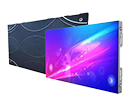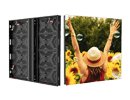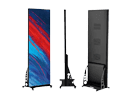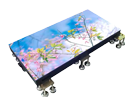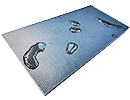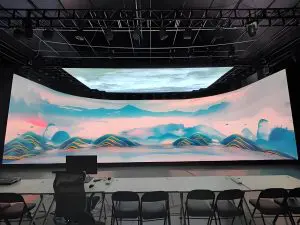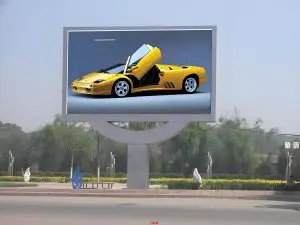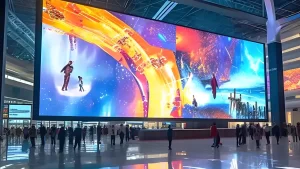Introduction
In the rapidly evolving world of visual technology, LED displays have become the backbone of modern digital signage, entertainment venues, and control rooms. However, maintaining peak performance and longevity requires a dual focus on LED display maintenance and thermal design for LED systems. This comprehensive guide explores professional strategies to maximize ROI while ensuring reliability in demanding applications.
1. The Critical Role of Thermal Design in LED Display Longevity
1.1 Understanding Thermal Challenges in LED Systems
Modern high-brightness LED displays generate significant heat during operation:
- Typical power densities range from 300-500W/m² in indoor displays
- Outdoor installations can exceed 800W/m² under full brightness
- Junction temperature increases of 10°C can reduce LED lifespan by 50%
Key thermal design considerations:
- Heat dissipation efficiency (W/°C)
- Thermal interface material selection
- Convection vs. conduction cooling balance
- Environmental factors (ambient temperature, solar loading)
1.2 Advanced Thermal Management Solutions
Implement these thermal design for LED best practices:
A. Multi-Layer Heat Pathway Design
- 3D vapor chamber technology for high-power LED clusters
- Graphene-enhanced thermal interface materials (TIMs)
- Active cooling systems with PWM-controlled fans
B. Environmental Adaptation
- IP65-rated forced air cooling for outdoor displays
- Phase-change materials (PCMs) for temperature buffering
- Smart thermal throttling algorithms
C. Predictive Maintenance Integration
- Real-time temperature mapping with IoT sensors
- Machine learning-based failure prediction
- Automated cooling system diagnostics
2. Professional LED Display Maintenance Protocols
2.1 Preventative Maintenance Framework
Develop a systematic LED display maintenance schedule:
| Component | Inspection Frequency | Key Parameters |
|---|---|---|
| LED Modules | Quarterly | Luminance decay, color shift |
| Power Supplies | Bi-monthly | Voltage stability, ripple |
| Cooling Systems | Monthly | Fan RPM, filter cleanliness |
| Control Systems | Semi-annually | Firmware updates, signal integrity |
2.2 Critical Maintenance Procedures
A. Optical Performance Optimization
- Use spectroradiometers to monitor:
- Chromaticity coordinates (CIE 1931)
- Luminance uniformity (±5% tolerance)
- Color temperature consistency
B. Electrical System Maintenance
- Perform IR thermography to identify:
- Overheated driver ICs
- Voltage regulator degradation
- Connector contact resistance
C. Mechanical Integrity Checks
- Torque verification for module mounting
- Sealant integrity testing (ASTM C920)
- Structural vibration analysis
3. Synergizing Maintenance and Thermal Management
3.1 Thermal-Related Failure Modes
Common issues addressed through combined LED display maintenance and thermal design:
- SMT LED Tombstoning: Caused by uneven thermal expansion (CTE mismatch)
- Driver IC Degradation: Accelerated by junction temperatures >85°C
- Color Shift: Δu’v’ > 0.005 correlates with 15°C temperature increase
3.2 Maintenance-Driven Thermal Optimization
Implement these cross-functional strategies:
A. Dynamic Thermal Profiling
- Create seasonal maintenance protocols based on:
- Historical temperature data
- Display utilization patterns
- Local climate conditions
B. Modular Cooling System Design
- Hot-swappable fan trays with RFID tracking
- Filter-less designs using electrostatic precipitation
- Liquid cooling quick-disconnect interfaces
C. AI-Powered Predictive Analytics
- Combine thermal imaging data with:
- Power consumption trends
- Pixel failure rates
- Environmental sensor inputs
4. Emerging Technologies in LED Thermal Management
Stay ahead with these innovations in thermal design for LED:
- Microfluidic Cooling Arrays
- Embedded channels with flow rates <5 mL/min
- 40% improvement in thermal resistance vs. conventional heatsinks
- Thermoelectric Cooling (TEC) Integration
- Peltier devices for spot cooling of driver components
- COP improvements through GaN-based modules
- Phase-Change Materials (PCMs)
- Paraffin-based composites with 200-250 J/g latent heat
- Effective for peak load thermal buffering
5. ROI Optimization Through Smart Maintenance
Implement these cost-saving strategies:
- Condition-Based Maintenance
- Reduce downtime costs by 35-40%
- Extend component lifespan by 20-25%
- Modular Repair Strategies
- Field-replaceable LED tiles with <5 minute swap time
- Hot-swappable power modules with auto-recognition
- Energy Efficiency Improvements
- Adaptive cooling systems saving 15-20% in power
- Thermal-optimized drive currents reducing LED stress
Conclusion: Building Sustainable LED Display Systems
By integrating advanced thermal design for LED technologies with proactive LED display maintenance practices, operators can achieve:
- 50,000+ hour MTBF (Mean Time Between Failures)
- <3% annual brightness degradation
- 30% reduction in total cost of ownership
As LED technology advances toward microLED and direct-view applications, thermal management and maintenance protocols will remain critical differentiators in display performance and reliability. Implement these strategies today to future-proof your investment in LED display technology.

